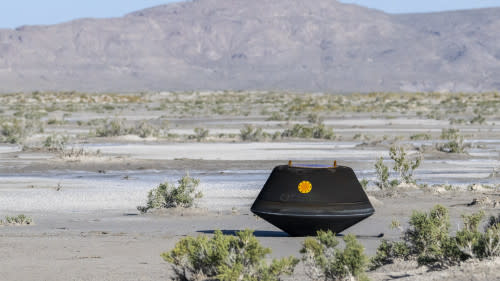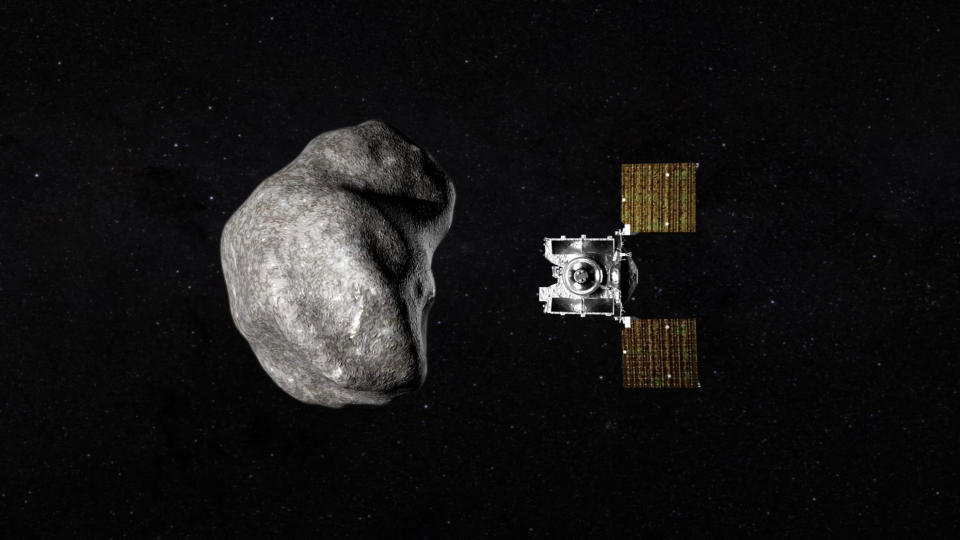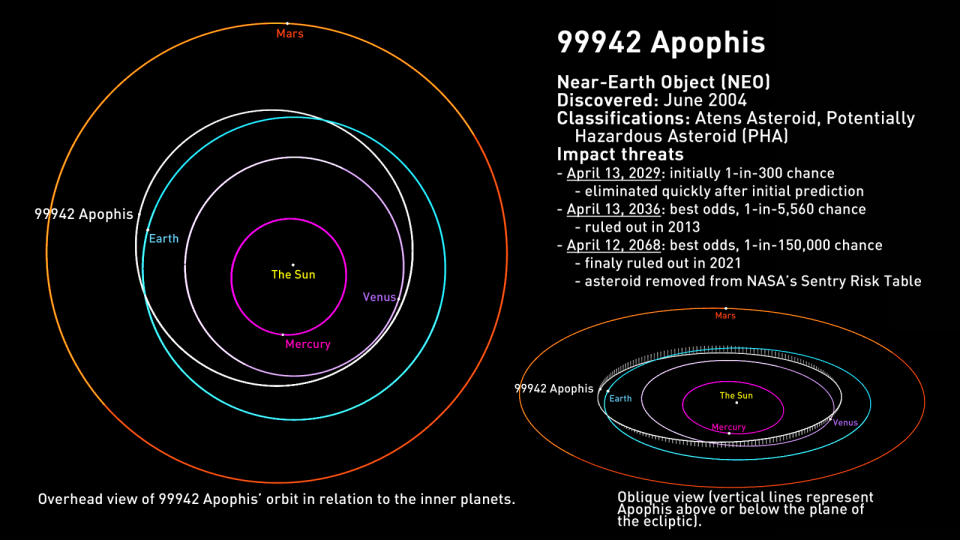NASA's OSIRIS-REx successfully delivers asteroid Bennu samples to Earth

Returning home after a 7-year mission in space, NASA's OSIRIS-REx mission has dropped off its precious cargo to scientists here on Earth and is now rocketing off to explore yet another potentially hazardous near-Earth asteroid.
On the morning of Sunday, September 24, a small capsule plunged into Earth's atmosphere from space, completing a journey of over 6 billion kilometres with the OSIRIS-REx spacecraft as it settled to the ground in the Utah desert at 10:52 a.m. EDT. Contained within this capsule are pristine samples of near-Earth asteroid Bennu that were collected back in October 2020 by OSIRIS-REx, the Origins, Spectral Interpretation, Resource Identification and Security – Regolith Explorer.

OSIRIS-REx's sample return capsule is seen here shortly after touching down in the desert, Sunday, Sept. 24, 2023, at the Department of Defense's Utah Test and Training Range. Credit: (NASA/Keegan Barber)
According to NASA, the sample container was retrieved by teams standing by at the U.S. Department of Defense's Utah Test and Training Range. It was then air-lifted to a nearby clean room to be examined, and it will eventually be delivered to NASA's Johnson Space Center in Houston, Texas.
Once the samples from Bennu are extracted from the container, they will be kept isolated from Earth's environment so that scientists can study the materials virtually unchanged from how they were on Bennu's surface.
"Today marks an extraordinary milestone not just for the OSIRIS-REx team but for science as a whole," Dante Lauretta, principal investigator for OSIRIS-REx at the University of Arizona, Tucson, said in a NASA press release. "Successfully delivering samples from Bennu to Earth is a triumph of collaborative ingenuity and a testament to what we can accomplish when we unite with a common purpose."
"But let's not forget," Lauretta continued" "While this may feel like the end of an incredible chapter, it's truly just the beginning of another. We now have the unprecedented opportunity to analyze these samples and delve deeper into the secrets of our solar system."
Why is this important?
This mission to Bennu — NASA's first asteroid sample return and the very first sample return mission for the Canadian Space Agency — is important for two reasons.
First, because the samples brought back have likely been virtually unchanged for billions of years. Examining those materials up close will give scientists a clear view of the conditions at the birth of our solar system.

This view of Bennu is stitched together from 12 separate images taken by OSIRIS-REx's PolyCam instrument when the spacecraft was just 24 kilometres from the asteroid. Credit: NASA/Goddard/University of Arizona
Second, Bennu is a half-kilometre-wide asteroid that NASA considers one of the riskiest to our planet. The chances of this asteroid colliding with Earth are slim — only around 0.037 per cent, or about 1 in 2,700 — and even then, the date of that potential impact is at least 159 years away. Still, being near the top of NASA's Sentry Risk table makes Bennu an excellent target for study if we ever need to deflect it from a disastrous trajectory.
Bennu's structure complicates matters, though. It's not one big solid piece of rock. Instead, it's a 'rubble pile' — a collection of rocks and dust all travelling together and only held together by the weak gravity between all the separate pieces. If you could instantly transport the asteroid to Earth's surface, it would simply collapse into a big heap of stones.

This sketch details Bennu's origin and size and gives an idea of the most likely internal structure of the asteroid. Credit: James Tuttle Keane/Nature Geosciences
In fact, when OSIRIS-REx performed its TAG maneuver to collect the sample it just returned, the team was shocked to learn that the spacecraft's arm sunk around half a meter into the loose surface. Who knows what could have happened if the probe's thrusters hadn't fired on time to push it away. The mission may have ended there, as OSIRIS-REx became buried in the rubble pile!
Last year, NASA demonstrated the 'kinetic impactor' method of planetary protection when they slammed the DART spacecraft into asteroid 'moon' Dimorphos.
However, this method wouldn't work very well for an asteroid like Bennu. Learning about its structure and closely examining the rocks it's composed of could provide clues about how to best divert such a threat.
Samples for Canada
Once the samples are removed from their container, NASA will take stock of how much OSIRIS-REx collected.
Twenty-five per cent of the material will be available for researchers in the United States. Four per cent will come to Canada for our contributions to the mission, and Canadian scientists at institutions across the country will be examining those materials. Around 1 per cent will go to Japan due to partnerships involving the JAXA Hayabusa 2 mission. The remainder, a little over 70 per cent of the total, will be locked away for future study.
Dr. Kim Tait, the Curator of Mineralogy at Toronto's Royal Ontario Museum, has been studying materials similar to Bennu that have been found here on Earth. These are carbonaceous chondrite meteorites, which contain a large amount of carbon and water, and are composed of minerals formed in the presence of water.

These charcoal-black meteorite fragments are from the Tagish Lake meteorite, which fell on January 18, 2000, and were recovered just hours after they struck the ground. These meteorites are some of the most pristine we know about. Pieces of this meteorite are being studied at the University of Alberta and the Royal Ontario Museum. Credit: Chris Herd/University of Alberta
"What I focus on are the minerals," Dr. Tait told The Weather Network. "How the minerals are forming, how they formed together, and which minerals are present. It all reads like a book. I can read the different pressures, the temperatures, and the elements that were present."
Meteorites are an excellent way to study the conditions at the beginning of the solar system. However, the materials collected from Bennu have been unchanged for billions of years and will undoubtedly provide us with insights that have been lost due to meteorites being changed by Earth's environment.

This image, taken on March 7, 2019, by the PolyCam camera on NASA's OSIRIS-REx spacecraft from a distance of about 5 km, shows a view across asteroid Bennu's southern hemisphere and into space. It demonstrates the number and distribution of boulders across Bennu's surface. The large, light-coloured boulder just below the center of the image is about 7.4 meters wide, roughly half the width of a basketball court. Credits: NASA/Goddard/University of Arizona
"This is like a snapshot in time, from the very beginning of the solar system, and some of these materials could be pre-solar system," Tait explained. "Getting our hands on a very primitive sample, that's full of carbon, which can be the building blocks of life, is super exciting."
Off to Apophis
Now that OSIRIS-REx has completed its primary mission, it has a new goal and a new name to go along with it.
OSIRIS-APEX — the Origins, Spectral Interpretation, Resource Identification and Security - APophis EXplorer — is now on its way away from Earth, headed for a rendezvous with Apophis, an asteroid even more infamous than Bennu.

This artist's rendition shows the OSIRIS-APEX spacecraft pulling alongside asteroid Apophis after it has passed Earth in 2029. Credit: NASA/University of Arizona
Bennu's very slight chance of impacting Earth in the far future makes it worthy of our attention. Still, astronomers really just need to keep an eye on it from time to time.
Apophis, on the other hand, has caused some genuine worries.
When it was discovered in 2004, simulations of its orbit revealed an alarmingly high chance of it hitting Earth in April of 2029. Fortunately, further observations refined its orbit, and it was found that there was no impact risk at that time. Instead, the asteroid will pass by at a distance of around 32,000 km, or roughly one-tenth of the distance to the Moon.
Even as that threat was ruled out, though, the asteroid's close pass brought up a potential impact in 2036 and another in 2068. As telescopes tracked the asteroid's path through space and scientists studied its orbit, all threats from Apophis were eventually ruled out, and it was even completely removed from NASA's Sentry Risk table in February 2021.

Apophis' orbit around the Sun is shown here, both from above and from an angle, along with details of the asteroid's past and present threat level. Credit: NASA/JPL/CNEOS/Scott Sutherland
Still, even though Apophis is no threat to us now, the close encounter in 2029 is an excellent opportunity to study another near-Earth asteroid. Rather than build a whole new spacecraft, since OSIRIS-REx is still healthy and has plenty of fuel, NASA renamed it and sent it speeding off to this new target.
Once it catches up, just after the April 2029 Earth flyby, it will spend about 18 months studying Apophis. The main objectives will be to see how its close pass affected the asteroid and its path through space, which will give us new insights into its potential behaviour in the future (and any other possible risks it might pose).

